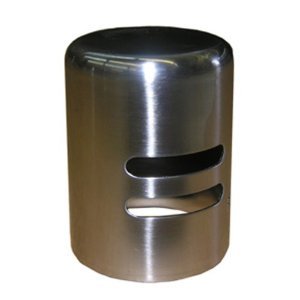Table of Contents
The Air Gap: Unveiling Its Role in Your Dishwasher
Have you ever wondered what that peculiar-looking device on your dishwasher’s countertop is? It’s called an air gap, and while it may seem like an inconspicuous component, it plays a crucial role in ensuring the smooth functioning and safety of your dishwasher. In this blog post, we’ll dive into the world of dishwashers and explore the purpose of the air gap.
What is an Air Gap?
An air gap is a small, visible device installed on the countertop near your sink. It consists of a metal or plastic cylinder with an open top. Inside the cylinder, there is a small gap or hole that allows air to flow. The air gap is connected to the dishwasher drain hose and the sink’s drainpipe or garbage disposal.
Function and Importance:
- Preventing Backflow:
The primary function of the air gap is to prevent backflow, which is the reverse flow of dirty water from the sink into the dishwasher. During the dishwasher’s operation, wastewater containing food particles and other debris is pumped out through the drain hose. Without an air gap, there’s a potential risk of contaminated water flowing back into the dishwasher, leading to unhygienic conditions and potential damage.
- Ensuring Compliance with Plumbing Codes:
Many local plumbing codes and regulations require the installation of an air gap in dishwashers. These codes exist to safeguard public health by preventing cross-contamination between the dishwasher and the sink’s water supply. By complying with these codes and installing an air gap, you help maintain a safe and sanitary kitchen environment.
- Acting as a Backup:
In case of a clog or blockage in the sink’s drainpipe or garbage disposal, the air gap serves as a vital backup mechanism. If the drainage pathway is obstructed, the air gap provides an alternative route for the dishwasher’s wastewater to flow, preventing it from flooding your kitchen floor.

Maintenance and Troubleshooting:
The air gap, like any other dishwasher component, requires periodic maintenance to ensure its optimal functionality. Here are a few tips:
- Regular Cleaning:
Food particles and debris can accumulate in the air gap, obstructing the flow of air and water. To prevent clogs and maintain proper functioning, clean the air gap periodically by removing the top cap and rinsing it thoroughly.
- Checking for Leaks:
Occasionally inspect the air gap for any signs of leaks or water seepage. If you notice a leak, it could indicate a blockage or a malfunctioning air gap. In such cases, consider consulting a professional plumber to resolve the issue.
Conclusion:
The humble air gap, often overlooked, plays a vital role in ensuring the cleanliness and safety of your dishwasher and kitchen environment. By preventing backflow, adhering to plumbing codes, and acting as a backup mechanism, the air gap contributes significantly to the efficient operation of your dishwasher. Remember to perform regular maintenance checks and clean the air gap to maintain its optimal functionality. So, the next time you glance at your dishwasher’s countertop, you’ll appreciate the silent yet indispensable role of the air gap in keeping your dishes sparkling clean.
What is the purpose of an air gap in a dishwasher?
The air gap in a dishwasher serves multiple purposes. Its primary function is to prevent backflow, ensuring that dirty water from the sink does not flow back into the dishwasher. It also helps to comply with plumbing codes and regulations by preventing cross-contamination. Additionally, the air gap acts as a backup mechanism in case of drainpipe or garbage disposal blockages.
How does an air gap work?
An air gap works by creating a physical separation between the dishwasher and the sink’s drainpipe or garbage disposal. The air gap is connected to the dishwasher’s drain hose and the sink’s drainpipe. When the dishwasher drains water, it creates a suction effect that draws air through the gap, preventing backflow of water from the sink into the dishwasher.
Is an air gap necessary for a dishwasher?
In many jurisdictions, the installation of an air gap is required by plumbing codes. It is considered an essential safety feature to prevent cross-contamination and maintain hygienic conditions in the kitchen. While some modern dishwashers may have alternative mechanisms for backflow prevention, an air gap remains a widely accepted and reliable solution.
Can I remove or bypass the air gap in my dishwasher?
It is generally not recommended to remove or bypass the air gap in a dishwasher, especially if it is required by local plumbing codes. Doing so can compromise the dishwasher’s safety and may lead to potential contamination issues. If you are considering removing or bypassing the air gap, consult a professional plumber to ensure compliance with regulations and to explore alternative solutions.
How do I maintain and clean the air gap?
Regular maintenance and cleaning of the air gap are important to ensure its proper functioning. To clean the air gap, remove the top cap and rinse it thoroughly to remove any food particles or debris. Check for any signs of leaks or water seepage, and if necessary, consult a professional plumber for repairs or replacements.
Can a malfunctioning air gap cause issues with my dishwasher?
Yes, a malfunctioning air gap can lead to problems with your dishwasher. If the air gap is clogged, damaged, or not functioning correctly, it may result in backflow of dirty water into the dishwasher or inadequate drainage. This can lead to unsanitary conditions, damage to the dishwasher, and potential leaks. If you suspect issues with your air gap, it is advisable to have it inspected and repaired by a professional.

